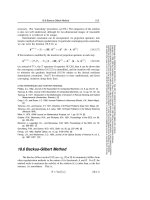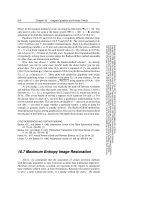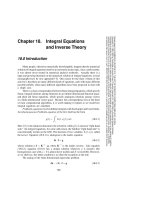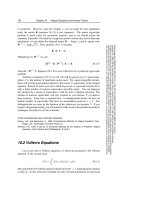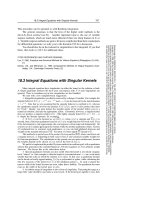differential equations and control theory
Bạn đang xem bản rút gọn của tài liệu. Xem và tải ngay bản đầy đủ của tài liệu tại đây (3.4 MB, 481 trang )
Completely Revised
and Updated
Third Edition
Digestive
Wellness
Elizabeth Lipski, Ph.D., CCN
Copyright © 2005 by Elizabeth Lipski. All rights reserved. Manufactured in the United States
of America. Except as permitted under the United States Copyright Act of 1976, no part of this
publication may be reproduced or distributed in any form or by any means, or stored in a
database or retrieval system, without the prior written permission of the publisher.
0-07-146008-X
The material in this eBook also appears in the print version of this title: 0-07-144196-4.
All trademarks are trademarks of their respective owners.
Rather than put a trademark symbol
after every occurrence of a trademarked name, we use names in an editorial fash
ion only, and
to the benefit of the trademark owner, with no intention of infringement of the trademark.
Where such designations appear in this book, they have been printed with initial caps.
McGraw-Hill eBooks are available at special quantity discounts to use as premiums and sales
promotions, or for use in corporate training programs. For more information, please contact
George Hoare, Special Sales, at or (212) 904-4069.
TERMS OF USE
This is a copyrighted work and The McGraw-Hill Companies, Inc. (“McGraw-Hill”) and its
licensors reserve all rights in and to the w
o
rk. Use of this work is subject to these terms.
Except as permitted under the Copyright Act of 1976 and the right to store and retrieve one
copy of the work, you may not decompile, disassemble, reverse engineer, reproduce, modify,
create derivative works based upon, transmit, distribute, disseminate, sell, publish or
sublicense the work or any part of it without McGraw-Hill’s prior consent. You may use the
work for your own noncommercial and personal use; any other use of the work is strictly
prohibited. Your right to use the work may be terminated if you fail to comply with these
terms.
THE WORK IS PROVIDED “AS IS.” McGRAW-HILL AND ITS LICENSORS MAKE NO
G
UAR
ANTEES OR WARRANTIES AS TO THE ACCURACY, ADEQUACY OR
COMPLETENESS OF OR RESULTS TO BE OBTAINED FROM USING THE WORK,
INCLUDING ANY INFORMATION THAT CAN BE ACCESSED THROUGH THE WORK
VIA HYPERLINK OR OTHERWISE, AND EXPRESSLY DISCLAIM ANY WARRANTY,
EXPRESS OR IMPLIED, INCLUDING BUT NOT LIMITED TO IMPLIED WARRANTIES
OF MERCHANTABILITY OR FITNESS FOR A PARTICULAR PURPOSE. McGraw-Hill
and its licensors do not warrant or guarantee that the functions contained in the work will meet
your requirements or that its operation will be uninterrupted or error free. Neither McGraw-
Hill nor its licensors shall be liable to you or anyone else for any inaccuracy, error or omission,
regardless of cause, in the work or for any damages resulting therefrom. McGraw-Hill has no
responsibility for the content of any information accessed through the work. Under no
circumstances shall McGraw-Hill and/or its licensors be liable for any indirect, incidental,
special, punitive, consequential or similar damages that result from the use of or inability to
use the work, even if any of them has been advised of the possibility of such damages. This
limitation of liability shall apply to any claim or cause whatsoever whether such claim or cause
arises in contract, tort or otherwise.
DOI: 10.1036/007146008X
Contents
Foreword ix
Preface xi
Acknowledgmentsxiii
Introduction: Who Can Benefit from This Book? xv
1 The American Way of Life Is Hazardous
to Our Health 1
Food and the Environment 6
Food Preparation and Technology 7
Food Additives • The Microwave • Genetic Engineering •
Food Irradiation
The Changing American Lifestyle 12
Over-the-Counter Pain Relievers • Antibiotics • Pollution
and Environmental Toxins
The Will to Change 14
2A Voyage Through the Digestive System 17
Yo u Aren’t Only What You Eat 18
A Guided Tour Through the Digestive System 21
The Brain • The Mouth • The Esophagus • The Stomach:
The Body’s Blender • Small Intestine • The Pancreas • Gut-
Associated Lymphatic Tissue (GALT) • Gut Serotonin • The
Liver: The Body’s Fuel Filter • The Gallbladder: A Holding
Ta n k for Bile • The Large Intestine or Colon
iii
3 The Bugs in Your Body: Intestinal Flora 37
The Many Benefits of Intestinal Flora 40
Probiotic Bacteria Help Us in Many Ways
Not All Intestinal Bacteria Are Friendly 48
Prebiotics 48
Foods and Herbs That Enhance Intestinal Flora 50
Probiotic Supplements 52
Dosage
4Dysbiosis: A Good Neighborhood Gone Bad 55
What Causes Dysbiosis? 62
Patterns of Dysbiosis 65
Putrefaction Dysbiosis • Fermentation Dysbiosis • Deficiency
Dysbiosis • Sensitization Dysbiosis
Candida: The Masquerader 68
5 Leaky Gut Syndrome: The Systemic
Consequences of Faulty Digestion 81
What Causes Leaky Gut Syndrome? 86
Chronic Stress • Dysbiosis • Environmental Contaminants •
Overconsumption of Alcoholic Beverages • Poor Food
Choices • Use of Medication
Restoring Gut Integrity 88
Food and Environmental Sensitivities 89
Lectins 93
Elimination-Provocation Diet 94
6 Functional Medicine and Functional Testing 97
Acid-Alkaline Balance and pH Testing 98
Home pH Testing
Comprehensive Digestive Stool Analysis (CDSA) 106
iv
Contents
Parasitology Testing 107
Elimination-Provocation Food Sensitivity Testing 114
Food Allergy/Sensitivity Testing 115
Leaky Gut Syndrome or Intestinal Permeability Testing 116
Heidelberg Capsule Test 116
Functional Liver Profile Testing 117
Indican Test 119
Lactose Intolerance Testing 119
Hair Analysis 121
Small Bowel Bacterial Overgrowth Test 121
Electrical Acupuncture Voltage (EAV) Testing 122
Organic Acid Te s t i n g 123
7Moving Toward a Wellness Lifestyle 125
8 First Things First: Detoxification 131
Detoxification Programs 134
Fruit and Vegetable Cleansing 134
Metabolic Cleansing 136
Vitamin C Flush 137
Low-Temperature Saunas and Steams 138
9 Diet Means “A Way of Living” 145
Clean Out the Pantry 146
Rules for Eating, Cooking, and Shopping 148
Eat Local Foods in Season • The Life in Foods Gives Us Life •
Plan Ahead: Carry Food with You • Eat Small, Frequent
Meals to Sustain Even Energy Levels • Eat When You Are
Hungry; Stop When You Are Satisfied • Relax While Eating
• Choose Organically Grown Foods Whenever Possible • Eat
as Many Fruits and Ve getables as Possible • Eat Lean Protein
Including High EPA and DHA Fish One to Two Times a
Contents
v
We ek • Drink Clean Water • Respect Your Own Biochemical
Uniqueness • Increase High-Fiber Foods
A Guide to Buying Food 160
Cereals and Grains • Eggs • Fish and Seafood • Seaweeds •
Meat and Poultry • Oils, Nuts, and Seeds
Shopping List 164
Fruits and Vegetables • Legumes (Beans and Peas) • Whole
Grains • Whole Grain Breads • Breads and Pastas • Cereals •
Dairy Products and Eggs • Fish and Seafood • Meats and
Poultry • Beverages • Oils, Nuts, and Seeds • Condiments
10 Natural Therapies for Common Digestive
Problems 171
Mouth 173
Bad Breath or Halitosis • Cheilosis or Cracks in the Corners
of the Mouth and Lips • Gingivitis and Periodontal Disease •
Mouth Ulcers or Canker Sores • Thrush • Tongue Problems
Esophagus 183
Belching or Eructation • Heartburn or Gastric Reflux and
Hiatal Hernia • Barrett’s Esophagus
Stomach 190
Gastric Hypofunction or Hypochlorhydria • Gastric Ulcers
and Gastritis
Liver 203
Hepatitis • Cirrhosis
Pancreas 218
Gallbladder 220
Gallstones
Small Intestine 226
Flatulence or Intestinal Gas • Parasites • Celiac Disease, Sprue,
or Gluten Intolerance
vi Contents
Colon or Large Intestine 240
Constipation • Diarrhea • Diverticular Disease • Irritable
Bowel Syndrome • Inflammatory Bowel Disease: Crohn’s
Disease and Ulcerative Colitis • Hemorrhoids
11 Natural Therapies for the Diverse Consequences
of Faulty Digestion 279
Arthritis 280
Osteoarthritis • Rheumatoid Arthritis (RA) • Psoriatic
Arthritis • Ankylosing Spondylitis (AS)
Asthma 300
Behcet’s Disease (BD) 305
Chronic Fatigue Syndrome 311
Eczema or Atopic Dermatitis 321
Fibromyalgia 329
Food and Environmental Sensitivities 337
Migraine Headaches 343
Psoriasis 351
Schizophrenia 358
Scleroderma 362
Appendix: Resources 371
References 375
Index 439
Contents vii
This page intentionally left blank.
Foreword
I
’ve had the pleasure of having a professional exchange with Liz
Lipski for nearly nineteen years and have been impressed with
the way that she has kept abreast of the latest knowledge and
information in nutritional sciences—and how it applies to nutri-
tionally related chronic health problems. Her book, Digestive Well-
ness, opens the door to a new chapter in nutritional science. The
result will be the alleviation of a number of health problems that
many people have experienced for years, not knowing what to do
about them. We now recognize that the intestinal tract plays an
important role in determining our health other than just digest-
ing our food and getting rid of waste products. We are not “what
we eat” but rather “what we absorb from what we eat.” It is this
aspect of our digestive system that may, in fact, determine our
immune function, glandular activity, and neurological function. I
believe that Dr. Lipski’s book identifies these relationships well and
gets the reader to understand the complex interrelationships of our
digestive process—and the bacteria living in our digestive tract
that are in constant communication with us.
It may come as a great surprise to many readers of this book to
learn that the bacteria that live in our digestive tract are the largest
organ of the body, even though they’re not tied directly to the
body through the blood supply. Bacteria in our intestinal tract
weigh nearly three and a half pounds and are metabolically active,
releasing many substances into our blood that are absorbed across
the intestinal barrier. A number of these substances, such as
vitamins and amino acids, may be beneficial to our health, and
others, which come from harmful bacteria, may, in fact, alter our
ix
immune, nervous, or glandular systems in such a way as to increase
our susceptibility to chronic illness. Liz Lipski, in this book,
defines these relationships and indicates how an individual might
utilize nutritional intervention to reduce many of these problems.
This book will make a positive contribution to people’s under-
standing of the important relationship between gastrointestinal
physiology, diet, and health. For readers who are not familiar with
this exciting and important topic, this book will provide an intro-
duction and a guide to how they can gain better control over their
digestive function and its relationship to their health. It seems hard
to believe that our health is, to a great extent, controlled by that
thin, three-millimeter lining of our intestinal tract that we call the
gastrointestinal mucosa. The maintenance of its integrity so that
it does not become “leaky” is of tremendous importance. Dr. Lip-
ski’s book helps the reader to understand how to approach this
objective with precision.
Jeffrey Bland, Ph.D.
x
Foreword
Preface
I
originally wrote Digestive Wellness because I felt that new
research and applications in the field of digestion ought to be in
the hands of people who most need it. So I took the research and
translated it into usable language. It’s gratifying to be stopped in
the grocery store and told, “My fibromyalgia is gone since I read
your book and followed the advice” or “I sell Digestive Wellness in
my office so that my patients can really understand what we are
doing.”
I even love hearing that it’s the most stolen book from doctors’
waiting rooms!
This book was originally published in 1995. Since then, the
concepts presented have stood the test of time, gaining more
recognition and a flood of new research each year. When I first
wrote Digestive Wellness, only a small core of professionals used the
tools I’d described. Now there are thousands. My clients used to
come to me knowing little; now many of them are really knowl-
edgeable about digestive flora, leaky gut syndrome, dysbiosis, and
supplements.
The foundation of good health is lifestyle: eating foods that
agree with us, becoming emotionally hearty, finding joy and
pleasure in the life we lead and the people we interact with, taking
the correct supplements to balance our unique biochemistry, and
moving our bodies. When the body loses its ability to be adaptive,
we become ill. Healthy people have acute medical problems that
come and go. But when our health issues become chronic, it’s time
to figure out what we can do to stimulate our innate healing
systems.
xi
Digestive Wellness endeavors to give you the tools to help your-
self and others. It’s filled with practical information—steps you
can take at home, questions to ask your doctor, and lab tests that
can give you more insight into the underlying causes of your
health issues. It’s not meant to be read cover to cover. Pick a chap-
ter and work with it. Then choose another or just look at a spe-
cific illness and work backward to fill in your understanding of
how you might be adding gasoline to the flames of your illness.
In this edition, I’ve updated the information on health condi-
tions and diseases, added new remedies and expanded on others,
and highlighted some areas that deserve more attention, such as
acid-alkaline balance. I’ve also added new sections on Barrett’s
esophagus, hepatitis, cirrhosis, and Behcet’s disease.
I hope that you enjoy the journey through Digestive Wellness.
Live each day fully and stay open to the glory of the surprises
within it. Feel deeply. Appreciate the love and small and large
kindnesses around you. Let the people you care about know how
you feel. Laugh, live, love. Inhale the divine.
xii
Preface
Acknowledgments
S
o many people to thank. I’ll try to keep this short!
Thanks to:
Stephen Long, who opened the space in my life so that I
could initially write Digestive Wellness
My sons, Kyle and Arthur, who have generously shared me
with my work and who keep me endlessly entertained
Christopher Dennen, my husband and devoted partner
Stephany Evans, my agent; Michele Pezzuti, my editor;
Katherine Hinkebein, my project editor; and McGraw-
Hill for believing in my work
Susan Davis for her editing of the first edition—which was
considerable
Jeffrey Bland, Ph.D., for his foreword, again
Russell Jaffe, M.D., Ph.D., for his support and mentorship
And to the many people and companies who have shared their
time, knowledge, and materials: Stephen Barrie, N.D.; Leo Gal-
land, M.D.; Michael Murray, N.D.; Corey Resnick, N.D.; Bill
Shaddle; the late William Crook, M.D.; Ann Louise Gittleman,
M.S., CNS; Burt Berkson, M.D.; Patrick Hanaway, M.D.; Joanne
Zeis; Dorena Rode; Great Smokies Diagnostic Laboratory;
Elisa/Act Biotechnologies; Metagenics; and to my many clients
who teach me every day.
xiii
This page intentionally left blank.
Introduction
Who Can Benefit from This Book?
“If the patient has been to more than four physicians, nutrition is proba-
bly the medical answer.”
—Abraham Hoffer, M.D., Ph.D.
C
urrently, our country is facing an epidemic of digestive ill-
ness directly related to the foods we eat and the way we live.
One-third to one-half of all adults have digestive illness—more
than sixty-two million people. According to the Digestive Disease
Clearinghouse and Information Center, sixty to seventy million
Americans have digestive diseases, and digestive diseases comprise
13 percent of all hospital admissions. Except for the common cold,
digestive problems are the most common reason people seek med-
ical advice. It is the third largest category of illness in the United
States, with a cost of $87 billion in direct medical costs and an
additional $20 billion from the resulting 229 million days of lost
productivity.
Year after year, medications for digestive illness top the phar-
maceutical bestseller list. As a category, antiulcer medications hold
the top in worldwide sales of $17.4 billion. Zantac was introduced
in 1981 and quickly became the world’s bestselling drug and
remained on top for a decade. It has been surpassed by Prilosec,
which, initially a prescription drug, became available as an over-
the-counter medication in the fall of 2001 and had national sales
of more than $4 billion. Prevacid was introduced in 1995 for
ulcers and had national sales of more than $1.2 billion by 1998.
xv
Constipation plagues our nation. On average, each American pays
more than $500 a year on laxatives and fiber supplements alone.
Unfortunately, most digestive problems are treated sympto-
matically. You have a symptom, you take some medicine, and
voilà, you feel better again. This is a fairly good approach for an
occasional concern, but if you have a chronic health concern, this
remedy doesn’t address the underlying cause of the problem.
Symptoms of discomfort are our body’s way of saying, “Pay atten-
tion to me!” Digestive Wellness offers a comprehensive guide to
your total well-being. It gives you specific information so that you
can begin to understand the messages your body is giving you.
The function of digestion is to break down foods into basic
components for the cells to use for energy, as building materials
and catalysts. The uninterrupted flow of these nutrients into our
system is critical to our long-term health. When we eat poorly or
our digestion becomes blocked and sluggish, we compromise our
cells’ ability to work efficiently and healthfully.
The food that we eat is our most intimate contact with our
environment.We take food inside of our bodies and turn it into
us. Each day, several pounds of this “foreign” matter must be
processed. Seventy percent of the immune system is located in or
around the digestive system. Often called the second brain, the
digestive system can run independently of our brain, has more
nerve endings than the spine, and manufactures more neurotrans-
mitters than the brain. In fact, 90 percent of all serotonin is made
in the gut.
Most of us don’t think much about digestion unless it isn’t
working well. We don’t have to because it works automatically.
Michael Gershon, M.D., a great researcher in the field, says it well
as he talks about the feedback that the bowels give to the brain—
pain, bloating, and nausea. He says, “What these sensations from
the gut have in common is unpleasantness. The information from
the bowel that reaches consciousness, therefore, makes the gut an
xvi
Introduction
organ from which no one wishes to receive frequent progress
reports.”
This book is a resource for those with faulty digestion and the
people who care about them. Some of you might have serious
digestive illness, such as Crohn’s disease, irritable bowel syndrome,
or ulcerative colitis, while others might have simpler problems of
heartburn, indigestion, or constipation. In addition to obvious
digestive troubles, many other medical problems are caused by
faulty digestion. Arthritis, many autoimmune diseases, eczema,
food sensitivities, and psoriasis are digestive in origin. People with
migraine headaches nearly always have food sensitivities that trig-
ger the onset. Chronic fatigue syndrome, while initially triggered
by a virus, has a major digestive component as well. When diges-
tive competence is restored, many of these problems are resolved.
The causes of digestive problems are multifactorial. (See Fig-
ure I.1.) In fact, the only factor we can’t control is our genetic
makeup, and even that is more malleable than we previously
believed. Virtually all human illness results from the interaction
between our genetics and our environment and a balance between
inflammation and anti-inflammation.
Digestive Wellness provides you with a step-by-step plan for
making healthful changes in your lifestyle. The approach is from
a biological rather than a medical viewpoint. The standard med-
ical approach is to diagnose and provide “appropriate” treatment:
either drugs or surgery. The biological approach involves cleans-
ing, feeding, and nurturing your entire being—simple but effec-
tive tools to improve the way you feel. By understanding the
function of the various parts of the gastrointestinal (GI) tract and
looking for underlying causes of disease rather than mere treat-
ment of symptoms, we can begin to understand how to correct
our problems.
First, we explore the causes of digestive illness that are aggra-
vated by the American lifestyle. Then we take a trip through the
Introduction xvii
digestive tract where we find a beautifully orchestrated system of
integrated harmony. Then we look at the microbes that populate
our digestive universe. When they are out of balance, we feel the
effects. We move on to discuss dysbiosis and leaky gut syndrome,
which often underlie digestive illness and many seemingly unre-
lated health problems. These chapters provide the groundwork so
you can really understand the causes and effects of poor lifestyle
choices and medical therapies on your condition.
Functional medicine, which is concerned with early interven-
tion in health problems, is presented next. Early intervention
improves your chances of returning to full health. Information on
functional lab tests is detailed. This information is new, and most
physicians will be unfamiliar with many of these laboratory tests.
Ta ke t h is b o ok to your doctor’s office, and ask your doctor to
work with you in this new way.
xviii
Introduction
Digestive
Problems
Cigarette
smoking
Chronic
stress
Genetics
Medications,
prescribed and over
the counter
Infections
Lack of
dietary fiber
Environmental
toxins, irritants,
heavy metals
Low stomach
hydrochloric acid
Poor food
choices
Alcoholic
beverages
Lack of
exercise
Figure I.1 Causes of Digestive Problems
In the following chapters, we move on to self-improvement,
with information and practical tips on how to develop a well-
ness lifestyle. You’ll receive information about exercise, stress-
reduction programs, detoxification food choices, and shopping
lists. We’ll focus on a personal exploration of what makes you feel
better or worse and recommend approaches that support your
body’s ability to evoke its natural healing response. You will dis-
cover which habits make you feel vibrant and energetic and which
drain you.
The biological approach treats you as a whole person with
unique needs. It is based on the concept of biochemical individu-
ality. Just as each of us has a unique face, body, and personality, so
too do we each have a unique biochemistry. For example, one per-
son’s need for a specific nutrient can be thirty-fold higher or lower
than another individual’s. When it comes to food, one person’s
pleasure is another’s poison. Although you may believe that it’s
important to eat certain foods—such as bread, eggs, meat, milk,
oranges, and tomatoes—they may or may not be healthy for you.
It depends on how well your body can use them. Detoxification
programs are discussed as well: why you need to incorporate them
into your life, recommended programs, and what to expect dur-
ing detoxification.
Chapters 10 and 11 present self-care strategies for digestive and
related health problems, including information about the latest
research on nutritional and herbal therapies. Chapter 10 discusses
common digestive illnesses and conditions, and Chapter 11
explores problems that are the consequence of faulty digestion,
such as arthritic conditions, migraine headaches, and skin prob-
lems. Research has been gathered from clinicians and researchers
who are striving to learn how your body works and why it fails.
The goal is to help your body reach its own natural balance, which
will allow it to heal. Day in and day out, cell by cell, your body
continuously replaces itself. With the correct balance of work,
Introduction xix
rest, and nutrients, your body can become healthier each year. If
you build your “house” with excellent materials, it will stand the
test of time.
Finally, a resource guide is included. It lists professional orga-
nizations that can refer you to nutritionally oriented physicians,
health professionals, and laboratories.
Throughout the book are exercises and questionnaires designed
to increase your self-awareness of mind and body, help you shop
more wisely, breathe more deeply, relax more fully, and live more
freely. Even though we might not be aware of it, we all practice
medical self-care. When we get a headache, we take an aspirin or
go for a walk. If we have indigestion, we take an antacid or drink
ginger tea. We know when we’re too sick to go to work. Most of
the time, we make our own assessment and treatment plan,
expecting that the problem will pass with time. When these plans
fail, we seek professional help. This book will expose you to more
plans, new ideas, and the tools to be your own health expert. Just
as one tool won’t work for every job, not all of these tools will
work for you. But some will, and even the failures might give you
useful information.
The good news is that you can change the way you feel. The
bad news is that it takes work and personal commitment. The
journey can be an amazing voyage of self-discovery and self-
mastery. This book provides you with some of the tools you need.
In fact, the voyage is as interesting as the destination. So work,
relax, laugh, and remember to look out the window and enjoy the
scenery. This book is about taking control of your lifestyle to
increase your chances of getting healthier and more vibrant each
year.
xx
Introduction
DIGESTIVE HEALTH APPRAISAL QUESTIONNAIRE
Date:
———
This questionnaire will help you assess your digestive status. It is
not meant as a replacement for a physician’s care. The answers
will help you focus your attention on specific areas of need.
Medications Currently Used
Circle any of the following medications you are taking. Write
down the dosage and frequency.
Antacids
Laxatives
Cortisone
Antibiotic
Oral contraceptives
Prednisone
Antifungals
Ulcer medications
Tylenol (acetaminophen)
Anti-inflammatories
Aspirin
Stool softeners
Other
———
Food, Nutrition, and Lifestyle
Circle if you eat, drink, or use:
Alcohol
Luncheon meats
Candy
Margarine
Cigarettes
Soft drinks
Introduction xxi
Coffee
Sweets/pastries
Fast foods
Chewing tobacco
Fried foods
Circle if you:
Diet often
Do not exercise regularly
Are under excessive stress
Are exposed to chemicals at work
Are exposed to cigarette smoke
Total the number of items you circled in each list. When you
have completed all sections of the questionnaire, refer to “Inter-
pretation of Questionnaire” at the end for more information on
what these answers mean for your digestive health.
This next part of the questionnaire will help you discover
where your digestive system is imbalanced. It is a screening tool
and does not constitute an exact diagnosis of your problem.
However, it can point you in the right direction in determining
where the highest priorities lie in your healing process.
Circle the number that best describes the intensity of your
symptoms. If you do not know the answer to a question, leave it
blank. For yes or no questions, score one point for yes, zero
points for no. Total your score for each section to assess which
areas need your attention.
0 ϭ Symptom is not present/rarely present
1 ϭ Mild/sometimes
2 ϭ Moderate/often
3 ϭ Severe/almost always
xxii Introduction
Section A: Hypoacidity of the Stomach
1. Burping 0123
2. Fullness for extended time
after meals 0123
3. Bloating 0123
4. Poor appetite 0 1 2 3
5. Stomach upsets easily 0123
6. History of constipation 0123
7. Known food allergies 0123
Total
0–4: Low priority
5–8: Moderate priority
9ϩ: High priority
Section B: Hypofunction of Small Intestines and/or
Pancreas
1. Abdominal cramps 0123
2. Indigestion one to three hours
after eating 0 1 2 3
3. Fatigue after eating 0123
4. Lower bowel gas 0123
5. Alternating constipation
and diarrhea 0123
6. Diarrhea 0123
7. Roughage and fiber causes
constipation 0123
8. Mucus in stools 0123
9. Stool poorly formed 0123
10. Shiny stool 0 1 2 3
11. Three or more large bowel
movements daily 0123
Introduction xxiii
